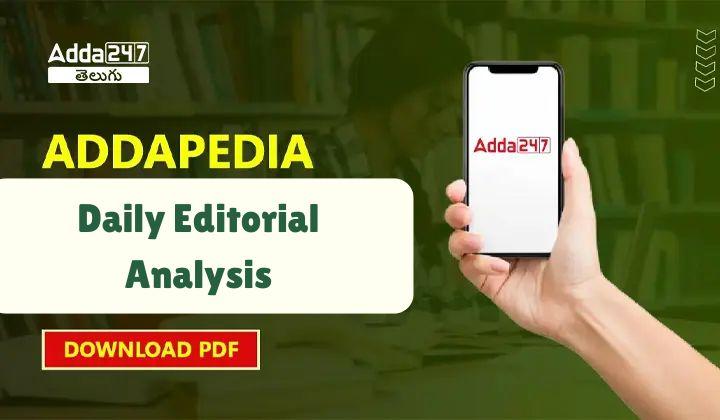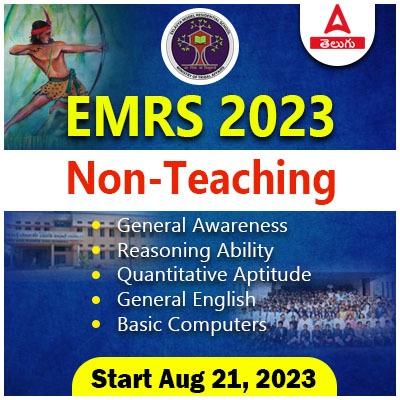Addapedia Editorial: Daily News Editorial PDF, 31 July 2024: Hello Aspirants ADDA 247 is back with Editorial Analysis in English. your daily source for in-depth news coverage and insightful editorial analysis. In this section, we bring you a comprehensive look at the latest national and international events, current affairs, and the historical context behind today’s most pressing topics. Our goal is to provide you with a well-rounded perspective on the news, helping you understand not just the headlines, but the intricate details and background that shape our world. This ADDAPEDIA Editorial Analysis will help you understand the National and International events Current affairs and the background of a particular topic. This comprehensive News analysis will help you in Clearing CA and Interview for many exams.
Adda247 APP
Kerala Landslide
At least 144 persons were killed and 197 injured after multiple landslides flattened some three villages in Vythiri taluk of the hilly Wayanad district of Kerala early on July 30.
What is landslide?
- A landslide is defined as the movement of a mass of rock, debris, or earth down a slope.
- They are a type of “mass wasting,” which denotes any down-slope movement of soil and rock under the direct influence of gravity.
- Landslides occur mainly in mountainous terrains where there are conducive conditions of soil, rock, geology and slope.
- Natural Causes that trigger it include heavy rainfall, earthquakes, snow melting and undercutting of slopes due to flooding.
- Landslides can also be caused by Anthropogenic Activities such as excavation, cutting of hills and trees, excessive infrastructure development, and overgrazing by cattle.
What are the Possible reasons behind Wayanad Landslide?
- Heavy rainfall: Heavy rains during the monsoon season trigger landslides in Kerala almost every year. However, this time the region received more than 140 mm of rainfall in the 24 hours five times more than what is expected leading to such disaster.
- Fragile geology: The terrain in Wayanad is characterized by a layer of soil sitting atop hard rocks. When the soil becomes saturated with water, it can easily slide over the underlying rock layer.
- Hilly terrain with sharp slopes: The whole of western Kerala, which is a hilly terrain with sharp slopes, is susceptible to landslides. 10 out of the 30 most landslide-prone districts in India were located in Kerala, with Wayanad ranked 13th.
- Loss of green cover: A 2021 study on landslide hotspots in India revealed that 59 per cent of the total landslides in Kerala occurred in plantation areas. Loss of forests increase the fragility of the terrain, especially in areas prone to heavy rains in the western ghats.
- Climate change: Climate scientists have pointed towards the warming of the Arabian Sea as one of the causes for the extremely heavy and unpredictable rain patterns in the state.
- The southeast Arabian Sea is becoming warmer, causing the atmosphere above this region, including Kerala, to become thermodynamically unstable.
- Scientists have noticed a trend of deep cloud systems forming due to the warming of the Arabian sea. This causes extremely heavy spells of rain in shorter periods of time, increasing the risk of landslides, especially when these intrude into land.
- Environmental neglect and mining: Madhav Gadgil committee had recommended that the Wayanad hill ranges be declared ecologically sensitive and restrictions of human activities to reduce the vulnerability to landslides. These have not been implemented.
What is the way forward?
- Comprehensive Risk Assessment and Mapping: Create detailed landslide susceptibility maps using remote sensing technology and surveys.
- Early Warnings: Install real-time monitoring systems to detect early signs of landslides, such as soil movement and groundwater levels.
- Land Use: Promote reforestation, regulate construction, and encourage soil conservation to stabilize slopes and reduce erosion.
- Engineering: Build retaining walls, drainage, and use bioengineering techniques to prevent soil saturation and slope failure.
- Community: Involve locals in planning and preparedness. Conduct regular drills and awareness campaigns to educate people about the risks and response measures.
- Policy: Formulate and enforce strict regulations on land use, construction, and mining in landslide-prone areas.
- Climate Change Adaptation: Integrate climate change projections into landslide risk assessment and planning.
- Financial Resources: Secure adequate funding for implementing these measures through government budgets, international aid, and private investment.
By adopting this comprehensive and integrated approach, it’s possible to significantly reduce the risk of landslides and protect lives, property, and the environment in Wayanad and other similar regions.
Can you answer the following question?
Landslides are a recurring natural disaster in hilly regions like Wayanad, often resulting in significant loss of life and property. Discuss the multi-dimensional factors contributing to these landslides and strategies to mitigate the risks involved.
Law Commission of India and the case for Law Advisory Council
There is scope to review the process of legal consultancy to the government on legal matters.
- The Supreme Court recently held Electoral Bonds Scheme unconstitutional due to its violation of voters’ right to information.
- Bharatiya Nyaya Samhita’s Hit-and-Run provision sparked a nationwide transporter strike due to concerns about its disproportionate application.
- The Supreme Court intervened in the Aadhaar Act case due to privacy concerns.
It is argued that a pre-emptive analysis by the an expert body like Law Advisory Council of India could have identified this issue and prevented the legal challenge.
What is the Law Commission of India (LCI) and its mandate?
- The LCI is a body established by the Government of India to recommend legal reforms.
- It functions under the Ministry of Law and Justice.
- Its primary role is to recommend reforms in existing laws.
- Mandate:
- To review and recommend reforms in the law to ensure it is in tune with current social needs and realities.
- To undertake research and make recommendations for the improvement of legal and judicial systems.
What are the criticisms of the Law Commission of India?
- Reactive Nature: The LCI’s role is primarily reactive, focusing on recommending reforms in existing laws rather than anticipating legal challenges and impacts of forthcoming laws.
- Ineffectiveness: Only 50% of the LCI’s recommendations have been implemented, suggesting a lack of influence and effectiveness.
- Low Output: Since its inception, the LCI has produced an average of only 4.19 reports per year, which is considered inadequate given the pervasive legal issues in the justice system.
- Low Level of Engagement: Between 2020 and 2024, the 22nd Law Commission prepared only four reports upon reference by the Government of India, indicating a low level of engagement between the government and the LCI.
What is the proposal of the Law Advisory Council, and what are the merits of having such a body?
The proposal is to establish a Legal Advisory Council (LAC) akin to the Economic Advisory Council (EAC). The LAC would work in conjunction with the PMO, unlike the LCI, which functions under the Ministry of Law and Justice.
The merits of having such a body is:
- Proactive Approach: The LAC aims to anticipate legal challenges and provide preemptive advice on proposed laws and policies.
- Enhancing Legal Vetting: Would strengthen the legal vetting process of proposed laws, reducing the chances of legal challenges and subsequent amendments.
- Independent Body: Would function independently alongside the Prime Minister’s Office (PMO), not under the Ministry of Law and Justice.
- Utilizing academic resources: The LAC could leverage the expertise of national law universities, making better use of the government’s investments in these academic institutions
- Diverse Expertise: Comprises legal experts, jurists, and academicians with diverse specializations in relevant fields of law.
- Complements LCI: The LAC would complement the LCI’s role by focusing on future challenges and filling the gaps in legal research and analysis.
Can you answer the following question?
The recent judicial interventions in various legislative initiatives of the government highlight the shortcomings of Law Commission of India and the need for a more nuanced and informed approach to law-making. In this context, discuss the merits of establishing a Legal Advisory Council (LAC) to aid the Prime Minister’s Office.
Download Daily News Editorial PDF
| Adda247 Telugu Home page | Click here |
| Adda247 Telugu APP | Click Here |













